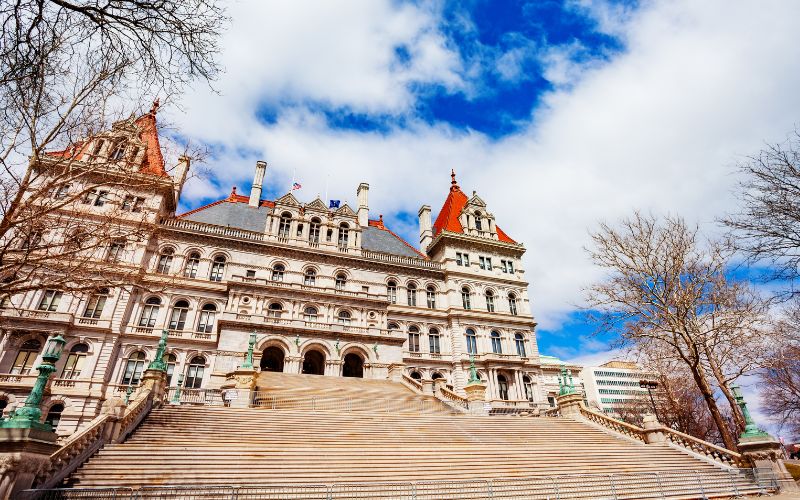
- Details
- By Jenna Kunze
Tribal nations in New York are being asked to participate in a review of artwork representing Indigenous peoples on display in the state’s capitol building.
Governor Kathy Hochul announced the new initiative on January 9, included in her annual report of the “state of the state” to the legislature.
“All New Yorkers should feel welcome and respected when visiting the State Capitol,” the governor’s 181-page steering document for her 2024 agenda reads. “Unfortunately, offensive imagery and distasteful representations of populations in the art that adorns the Capitol can alienate visitors. Indigenous peoples, in particular, are often depicted in artworks in a manner that reflects harmful racial stereotypes and glorifies violence against Indigenous peoples.”
Though the governor’s office does not keep a list of artwork depicting Indigenous peoples in the capitol building, Unkechaug Nation Chief Harry Wallace describes one memorable image from his diplomatic visits to the governor’s office. Last year, Wallace, who lives on the Poospatuck Reservation in Mastic, on Long Island, New York, sat in the waiting room for Hochul for a meeting to advance his decades-long fight for legislation to protect unmarked graves in the state of New York (legislation signed by the governor in early June).
On the ceiling of the reception room to the governor’s office—called the War Room— are several murals depicting French explorer Samuel Champlain defeating a Haudenosaunee man, captioned, “Champlain Killing First Indian.”
“It’s a hell of a way to begin a meeting with the governor,” Wallace tells Native News Online. “What is the message being portrayed? Is this indicative of what's acceptable to you?”
Now, Hochul is inviting representatives from each of New York’s nine federal and state-recognized tribes to participate in an advisory board that would review imagery in the capital and collectively recommend a response—including contextualizing existing artwork, or adding Indigenous art to the space—according to a spokesperson from the governor’s office. The governor would then make the final decision.
The initiative will be led by Elizabeth Rule, an enrolled citizen of the Chickasaw Nation of Oklahoma and the Deputy Secretary for First Nations. Governor Hochul created Rule’s role in June with the goal of strengthening nation-to-nation relationships with tribal nations in New York.
Seneca Nation President Rickey Armstrong senior called the art review in the state capital building “appropriate and overdue.”
Last year, the State Education Department issued a directive for school districts to stop the use of Native images and nicknames for school mascots. Armstrong said It's time for New York state itself to do the same.
“Our people have been here since before New York State existed,” he said in a statement to Native News Online. “We have helped to shape the state and the regions we have called home throughout history, and we play a major role today. Our contributions, our history, and our culture should be respectfully recognized and celebrated, instead of celebrating attacks and the attempted elimination of Native people. New York can and should do better."
More Stories Like This
Native News Weekly (August 25, 2024): D.C. BriefsUS Presidents in Their Own Words Concerning American Indians
Native News Weekly (January 18, 2026): D.C. Briefs
Federal Judge Orders ICE to Halt Use of Pepper Spray, Arrests of Peaceful Protesters in Twin Cities
Tunica-Biloxi Cultural Leader John D. Barbry Walks On
Help us defend tribal sovereignty.
At Native News Online, our mission is rooted in telling the stories that strengthen sovereignty and uplift Indigenous voices — not just at year’s end, but every single day.
Because of your generosity last year, we were able to keep our reporters on the ground in tribal communities, at national gatherings and in the halls of Congress — covering the issues that matter most to Indian Country: sovereignty, culture, education, health and economic opportunity.
That support sustained us through a tough year in 2025. Now, as we look to the year ahead, we need your help right now to ensure warrior journalism remains strong — reporting that defends tribal sovereignty, amplifies Native truth, and holds power accountable.
 The stakes couldn't be higher. Your support keeps Native voices heard, Native stories told and Native sovereignty defended.
The stakes couldn't be higher. Your support keeps Native voices heard, Native stories told and Native sovereignty defended.
Stand with Warrior Journalism today.
Levi Rickert (Potawatomi), Editor & Publisher


